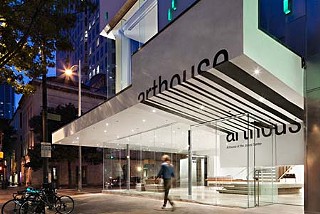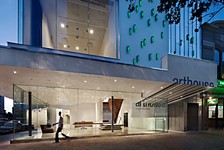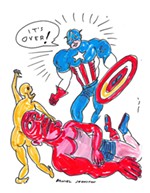Arthouse
Season of controversy at 700 Congress
By Robert Faires, Fri., April 22, 2011
With the opening of its newly renovated headquarters this past autumn, Arthouse enjoyed a season of celebration. But spring is proving to be a season of controversy for the visual arts institution. In March, a decision to restrict the viewing hours for the video installation Dorian, a cinematic perfume over concerns that it was inappropriate for teens – made without consulting artist Michelle Handelman – generated charges of censorship and homophobia. Arthouse sought to confront the matter head-on in a panel discussion, but that didn't completely defuse the dispute. As Handelman, who sat on the March 24 panel, noted in an interview in online arts journal ...might be good: "The real story is never revealed in the public discourse. Language is coded; panelists are coached; and proof of this comes in its wake, as several audience members who spoke out at the panel came up to me afterwards to privately voice the 'real story.' ... While the panel is an attempt at transparency, in the end it reveals very little about what actually happened."
Then during South by Southwest, Arthouse rented space to Warner Music Group for a promotional event. The second-floor gallery, which was filled with a large-scale installation by London artist Graham Hudson re-creating the layout of the Astoria rock club, was made available to Warner, which was allowed to put its posters on the walls and merchandise on the installation, essentially altering the artwork – again without consulting the artist. Coming so soon after the Handelman imbroglio, the situation prompted some in the visual arts community to suggest that Arthouse was being insensitive to the very artists it claims to champion.
Now, Arthouse is facing fire for an April 11 decision to eliminate the position of curator/associate director, effectively firing Elizabeth Dunbar, the only person who's held the job. In an email to the Chronicle, Executive Director Sue Graze explained that between the doubling of expenses brought on by the building expansion, a loss of revenue from the recession, and a failure to obtain an amplified sound permit for its rooftop deck (thus costing it a projected $100,000 in rentals), Arthouse was facing an extraordinary shortfall with five months left in the fiscal year. "When faced with impossible choices to reforecast and balance Arthouse's budget," Graze states, "we made the tough decision to make cuts that kept intact as much of the organization as possible and as many staff as possible. In addition, I took a 15% salary cut myself."
Graze adds that "Arthouse made a decision to rely on my significant curatorial career" at the Dallas Museum of Art and the Miami Art Museum "and the amazing talents of our two junior curators" for future exhibitions. Arthouse may indeed get along fine without Dunbar. Still, it is hard to reconcile the decision to make her job the first one on the chopping block, given Arthouse touting her as its first full-time curator when she was hired four years ago; the positive response to her work ("Florian Slotawa: One After the Other," "Matt Stokes: These Are the Days," "Liz Glynn: The 24 Hour Roman Reconstruction Project," getting Okay Mountain to the Pulse Contemporary Art Fair, et al.); and her promotion 16 months ago to associate director/curator. That's spurred speculation of personal motives behind the move, especially after word got out that Dunbar wrote the board a letter critical of the Arthouse leadership's handling of the Handelman and Hudson matters and warning that Arthouse's credibility was at stake.
Responses to the elimination of Dunbar's position have been the strongest yet, including resignations by Jenn Gardner of the staff and Houston artist Dario Robleto of the board. Artists who had planned to contribute work for Arthouse to sell in its annual Five x Seven fundraiser discussed withholding their submissions in protest. Some organized a Facebook event page called "Artists FOR Arthouse," which proposes that artists submit a blank 5-inch-by-7-inch card or an image expressing their dissent. Graze insists that "all boards signed by artists on the back will be displayed during the 5x7 opening parties and exhibition."
Graze adds that she welcomes contact from any artist who has concerns about Arthouse and recent events. She has heard from some already and says that "when they hear the complexity of the choices and plans for the future, we receive a lot of support. In addition, several have provided us with wonderful ideas to make the institution better. We are glad to be able to have constructive conversations that make Arthouse stronger."
Asked if there were anything about the Handelman and Hudson situations or the elimination of Dunbar's post that she would do differently, Graze responded: "Yes, in an effort to draw much needed revenue we made a decision that was not in the best interest of artist Graham Hudson's work, whom we deeply respect, and we regret that."











